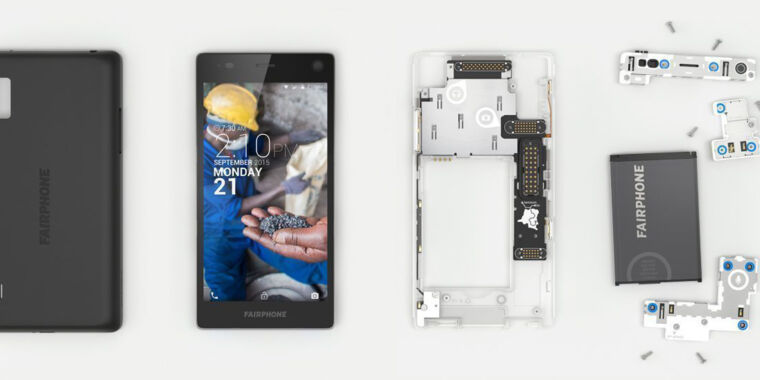
Fairphone – the modular, sustainable smartphone company – is still sending updates to the 5-year-old Fairphone 2. The company won’t win any speed awards, but the phone – launched in 2015 with Android 5 – is now being upgraded to Android 9.0. The most interesting part of this news is a video from Fairphone detailing the update process that the company went through, which offers more transparency than we normally receive from a smartphone manufacturer. To hear Fairphone tell the story of Android updates, the biggest barrier to long-term support is – surprise! – Qualcomm.
Fairphone wants consumers to keep their phones longer, creating less electronic waste and carbon emissions through modular replacement parts that are easily upgradeable and repairable. A major challenge in designing such a long-lasting phone is software support. Even if Fairphone wanted to support a phone forever, Android software updates don’t work that way, and major operating system updates typically depend on a relay race for companies that need to deliver an Android version before it arrives. to your phone.
We’ve talked about this before, but let’s quickly recap how Android gets to your smartphone. First, Google releases versions of AOSP (the Android Open Source Project) for everyone. However, this still doesn’t work on a phone. First, the manufacturer of your SoC (System on a Chip) (usually Qualcomm) needs to obtain it and customize Android for a particular SoC, adding drivers and other hardware support. This build then goes to your phone manufacturer (Fairphone, in this case), which adds support for the rest of the hardware – things like cameras, screens and any other accessories – along with integrated apps and any custom Android skin that the company wants to do.

Fairphone
With a 5 year old phone, the Fairphone 2 has a Qualcomm Snapdragon 801 SoC, which is a big problem if you are trying to provide long-term support. Fairphone software engineer Karsten Tausche explained in the video: “Qualcomm stopped supporting the chipset after Android 6, and that made upgrading to Android 7 much more difficult than, for example, upgrading to Android 6. ” Fairphone says it solved Qualcomm’s lack of support thanks to LineageOS, the largest custom ROM project in the Android community. Just as your SoC and hardware manufacturer would officially make AOSP builds ready for a device, Lineage also creates device-specific versions of Android and ready to boot from source and releases them to everyone as a replacement ROM. Qualcomm is the only company with full access to Qualcomm’s proprietary code blobs and hardware documentation, so an unofficially hacked build will generally not reach the level of polish you get from an official release supported by all companies. of hardware. Lineage usually lives in the realm of aftermarket phone repair, so that’s okay.
Fairphone is a licensed Google app, however, and this is an official release, so there is a high standard of quality. Lineage needs to pass Google’s approval process, also known as “Compatibility Test Suite”, a battery of tests that ensures that manufacturers have built Android correctly. The software will have no major application compatibility issues and will comply with all mandatory Google policies for Android. Fairphone almost seems critical of Google’s compatibility process, saying it “is getting more and more complex” with each new Android release, and Android 9 features “480,000” tests. Fairphone wasn’t sure if it could release an official version of Android 9 until it came up with solutions for all of Google’s testing requirements.
As for the company’s current phones, the Fairphone 3 and 3+, the company says it is planning an update to Android 11 in the second half of this year. Fairphone says Qualcomm is planning to eliminate support for the Snapdragon 632 chip that supports these phones in July 2021. Fairphone wants to deliver “at least one more important Android update” after Android 11, but that will mean doing another update without Qualcomm support.
As always with Android, things will get better in the future. Fairphone 3, as an Android 10 launch phone, supports Project Treble, a major redesign of Android that separates the operating system from hardware support. Treble was created to solve exactly the problem that the older Fairphone 2 is facing – the split means that a company could theoretically update Android without needing support from its chipset vendor.
Today, Qualcomm promises three years of chipset support for major upgrades, which was considered a major improvement over the two years it used to offer. This is still far from as long as Apple, which offers about five years of support for an iPhone. Qualcomm previously explained to Ars that “The support time for a chipset … is determined in collaboration with our customers”, but here is a customer asking for more support – and this is not happening.
Tausche closed the video saying that, although the job was difficult, Fairphone wanted to set an example. Tausche said: “We are proud to show the industry that, even with our small team, it is possible to support their phones for longer.”
